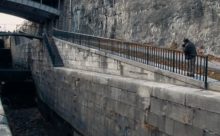Boom and Bust: Making of the Film
By Steve Zeitlin
In the spring of 2004, my wife Amanda and our two teenage kids were exploring where we might go on vacation. Europe was far too expensive, and I could never convince Amanda of my secret wish to rent an RV and travel around the country. “What about a Mississippi River boat?” my son asked. That sparked the memory of a folklore conference I had attended in upstate New York where someone mentioned that it was possible to rent a houseboat on the Erie Canal.
A few weeks later, our kids were at the wheel of the Mallard, an Erie Houseboat, which they joked was “Dad’s revenge,” an RV on the water. With the relaxation of a 5 mile an hour ride across the sleepy canal, I could actually hear my self think and look around. We rented a boat in Tonawanda and stopped in the sleepy towns of Medina, Holly, Brockport and Lockport. . I marveled at the early 20th century mechanical world of the locks on the canal. Many of these towns looked almost like ghost towns, half abandoned, with boarded up factories and storefronts. These seemed a far cry from the Erie Canal I learned about in school, opened in 1825, which made New York a world port and created the metropolises of Buffalo, Rochester, Syracuse, Utica and Albany.
I immediately called Dan Ward, a folklorist who grew up on and studied the canal and suggested a film. Together, we organized a meeting with Craig Williams, then a historian with New York State Museum, a group of upstate folklorists and Academy Award-winning filmmaker Paul Wagner. Paul brought his camera, and on that rainy day jumped out of the car and ran to a bridge to film the Day Peckinpaugh, the last commercial barge to work the canal, as it chugged under the bridge towards dry dock. That became the opening scene for our film – completed 10 years later. Our goal was to juxtapose two key eras in the Canal’s history: first, the era from the opening of the canal in 1825 through 1875, a time when the pioneering waterway made New York City a world port and the nation’s center of commerce, creating cities along its route from Buffalo, to Rochester, Syracuse, and Albany; second, the era from 1945-2000, marking the demise of the canal, and the loss of industry in many of the cities and towns along its route, an era in which tugboat captains and those who held manufacturing jobs in textile, steel and shipping tell of tough times, and bitter experiences. The film became a meditation on the American dream.
With a planning grant from the National Endowment for the Humanities we filmed a group of activists and historians, among them Wendy Wall, whom we filmed at the abandoned, decaying Seneca Textile Mill with pigeons roosting in its windows. In her interview, she summed up the story we had in mind to tell:
I think in a lot of ways the story of the Erie Canal really reflects the story of the nation as a whole. If you think about the early 19th century the story of the Erie Canal is one of nation building, the industrialization of America, the market revolution, the incredible florescence of reform and religious movements that went along with that. And, of course, the opening of the west, with the immigrants who traveled westward on the canal. It represents in one locale all that energy and optimism that in some ways made America.
If you look at the 20th century, it’s the story come first circle. The story of the Erie Canal becomes one of de-industrialization, of an emptying out of population, of a movement to the sunbelt away from the rustbelt, of globalization and the impact of that on the American economy.
Just as we finished filming the at the dilapidated old mill, a car pulled up and a woman jumped out to tell us that this shell of a building was the future home for the Women’s Hall of Fame. Ten years later, it is. At the same time, the Day Peckinpaugh is being transformed into a floating museum. Over those ten years of intermittent filming, we watched the transformation of the canal into a scenic byway and an engine not for industrialization but for cultural tourism. As Wendy put it,
If you look at what’s happening to the canal, in cities and towns all along its route communities are trying to make use of the canal in new ways. It’s now engine for tourism and economic development. So it’s really a story of America re-inventing itself. In many ways, that is our story.
